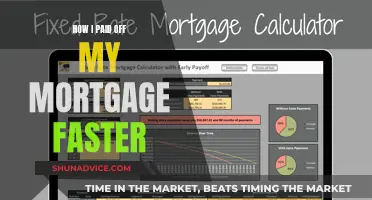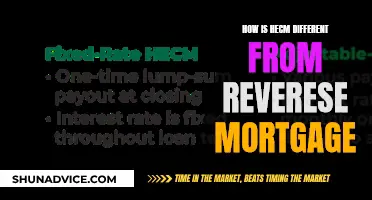
Home equity is the difference between the amount you owe on a mortgage and the current market value of your home. In other words, it is the portion of your home that you own outright. You can increase your equity by making mortgage overpayments, paying off a lump sum, or increasing the value of your home through renovations. Home equity is an asset and can be converted to cash by selling your home or borrowing against it. This can be done through a home equity loan, a home equity line of credit, or a cash-out refinance.
| Characteristics | Values |
|---|---|
| Definition | Home equity is the value of the portion of your home that you own. |
| Calculation | Home equity is calculated by subtracting the amount owed on a mortgage from the current value of the home. |
| Ownership | The percentage of the home that is owned by the buyer increases as the mortgage is paid off. |
| Down Payment | The down payment made when purchasing a home becomes the buyer's initial equity stake. |
| Loan Repayment | Regular repayment of the loan increases equity by reducing the amount owed on the mortgage. |
| Property Value | An increase in the property's market value can increase equity, while a decrease can reduce it. |
| Liabilities | Liens or other loans attached to the property can reduce equity. |
| Borrowing | Home equity can be borrowed against for purposes such as home improvements, debt consolidation, or education. |
| Insurance | Private mortgage insurance (PMI) may be required until a certain equity threshold is reached, typically 20%. |
| Refinancing | Equity affects the loan-to-value ratio (LTV) in refinancing, with higher equity resulting in more favourable terms. |
What You'll Learn

How to calculate equity
Home equity is the difference between the amount you owe on a mortgage and the current value of your home. It is the portion of your home that you own outright. You can calculate your home equity by taking your home's current market value and subtracting what you still owe on your mortgage.
To calculate your home equity, you will first need to estimate your home's value. You can do this by researching the value of similar homes in your neighbourhood that have sold recently. Once you have this figure, you can subtract your loan balance from your estimated home value. For example, if your home is worth $350,000 and your loan balance is $150,000, your home equity is $200,000.
Your down payment will also impact your home equity. The more you can afford for your down payment, the more home equity you will start with. For example, if you buy a home for $400,000 and make a 5% down payment, you will start with $20,000 in home equity. If you can afford a 10% down payment, you will have $40,000 in equity.
You can also build equity by paying down your mortgage balance and increasing the value of your home through renovations and improvements. Making extra payments towards your mortgage principal, such as biweekly payments or one additional payment per year, can help you build equity faster.
Home equity can be a powerful financial tool. It can be used to pay off debt, renovate your home, or make other financially savvy decisions. You can borrow equity with a cash-out refinance, home equity loan, or home equity line of credit (HELOC).
Creating Mortgage-Backed Securities: A Step-by-Step Guide
You may want to see also

Equity and loan-to-value ratio
Equity is the value of the portion of a home that the owner(s) actually possesses. In other words, it is the difference between what a home is worth and what is owed on a mortgage loan. For example, if a homeowner purchases a house for $300,000 with a 20% down payment, their equity in the house is $60,000.
Equity can be a powerful financial tool, as it can be used to pay off debt, renovate a home, or make other financially beneficial decisions. It can be built in several ways, including by paying down a mortgage, increasing the value of a home through renovations and improvements, or simply by making a larger down payment.
The loan-to-value (LTV) ratio is a number, expressed as a percentage, that compares the size of the loan to the lower of the purchase price or appraised value of the property. For example, a loan of $150,000 toward a house appraised at $200,000 represents 75% of the home's value, and therefore has an LTV ratio of 75%.
The LTV ratio is an important metric that helps mortgage providers determine how much they are willing to lend. It is also used to assess the level of risk associated with underwriting a mortgage. A higher LTV ratio indicates a higher level of risk for the lender, as there is a greater chance of the loan going into default.
The combined loan-to-value (CLTV) ratio is another important metric that includes all secured loans on a property, such as a second mortgage or home equity loan. This provides a more comprehensive assessment of a borrower's ability to repay a loan.
Lenders typically use an LTV threshold of 80% to determine eligibility for a loan and the associated interest rate. A lower LTV ratio is generally preferable, as it indicates a lower level of risk and can result in a lower interest rate for the borrower.
The Intricacies of Securing a Mortgage: What You Need to Know
You may want to see also

Equity and private mortgage insurance
Home equity is the difference between the amount you owe on a mortgage and the current value of the home. It is the portion of your home that you own outright, and it can be a powerful financial tool. You can borrow against your home equity to pay off debt, fund home renovations, or make other financially savvy decisions.
When you purchase a home, the down payment you make becomes your equity stake in the home. For example, if you make a 5% down payment, your starting equity is 5%. As you pay back the loan, the balance on your loan decreases, and your equity increases. Every payment you make slightly increases your equity.
Private mortgage insurance (PMI) is a type of insurance that lenders use to offset the risk of lending money to borrowers who have a low down payment (below 20%) when taking out a conventional loan. PMI protects the lender, not the borrower, if the borrower stops making loan payments. It is an extra expense for the borrower and can increase the cost of the loan. The cost of PMI depends on the borrower's credit score, the loan-to-value (LTV) ratio, the loan type, and the down payment amount. The higher the credit score and the lower the LTV ratio and down payment, the lower the PMI cost.
Borrowers are required to pay PMI until they reach 20% equity in their home, at which point they can request their lender to cancel the PMI. Federal law dictates that lenders must automatically cancel PMI when the LTV ratio drops to 78% or when the borrower is one month past the midpoint of their loan term, whichever comes first.
Home equity and PMI are interconnected, as PMI is often required when the borrower has less than 20% equity in the home. As the borrower pays down the mortgage and builds equity, they can eventually reach the 20% threshold and request to cancel PMI.
Mortgage Processors: Salary Insights and Payment Structure
You may want to see also

Equity and refinancing
Home equity is the difference between the amount you owe on a mortgage and the current value of the home. In other words, it is the portion of your home that you own outright. You can calculate your home equity by taking your home's current market value and subtracting what you still owe on your mortgage.
Equity can be a powerful financial tool. It can be used to pay off debt, renovate your home, or make other financially savvy decisions. For instance, you can use your home equity to get cash for tuition or to consolidate existing student loans into a single, lower-interest loan.
There are several ways to build equity in your home. Firstly, you can build equity by paying down your mortgage and increasing the value of your home. Every payment you make slightly increases your equity. You can also build equity by making a larger down payment, which will increase your starting equity.
If you are interested in borrowing against your home's available equity, you have a few options. One option is to refinance and get cash out. This option pays off your existing first mortgage and results in a new mortgage loan, which may have different terms than your original loan. Another option is to take out a home equity line of credit (HELOC), which is usually taken out in addition to your existing first mortgage.
Refinancing a home equity loan could result in big savings for homeowners. For example, with interest rates on personal loans and credit cards currently near record highs, rates on home equity loans are well under 10% and falling. Additionally, rates on home equity loans are fixed, allowing borrowers to accurately budget their repayments.
There are several potential benefits to refinancing a home equity loan. You can lower your monthly payments by pursuing a lower interest rate or changing the loan term to give you more time to pay it off. You can also reduce your loan term, making higher payments for a shorter amount of time, which will result in fewer interest payments in the long run. If your original home equity loan was not enough to finance your goals, refinancing may allow you to pull more money out of your equity.
HELOC vs Mortgage: Understanding the Key Differences
You may want to see also

Equity and cash-out refinance
Home equity is the difference between the amount you owe on a mortgage and the current market value of your home. In other words, it represents the percentage of your home that you own outright. You can calculate your home equity by subtracting the amount you owe on your mortgage from the amount your home is worth. For example, if your home is valued at $250,000 and you owe $150,000 on your mortgage, you have $100,000 in equity.
Equity can be a powerful financial tool, and you can borrow against it to meet important financial needs. You can access your equity by taking out a home equity loan or home equity line of credit (HELOC), or by using a cash-out refinance. This response will focus on the latter option.
A cash-out refinance is a type of mortgage refinance that lets you convert your home equity into cash. It replaces your existing home mortgage with a new, larger loan, and the loan proceeds are first used to pay off your existing mortgage(s), including closing costs and any prepaid items (e.g., real estate taxes or homeowners insurance). Any remaining funds are then paid to you. The cash you collect from a cash-out refinance is not taxed, as it is considered a loan and not income.
A cash-out refinance typically takes 30 to 45 days to complete, but this may vary depending on factors such as the size of your property, the complexity of your finances, and the time it takes to complete your appraisal and inspection. It is considered a second mortgage and will have its own term and repayment schedule separate from your first mortgage. You can use a cash-out refinance for any purpose, but it is important to carefully consider your financial situation before taking on additional debt.
When deciding between a cash-out refinance and other options, such as a home equity loan or HELOC, it is important to consider the potential benefits and costs of each. A cash-out refinance may offer a lower interest rate than other forms of debt, such as credit cards, and can provide a lump sum of cash to cover large expenses. However, it is important to note that a cash-out refinance typically comes with closing costs similar to those of a first mortgage, which can range from 2% to 5% of the loan amount.
Reconveyance Wording: Understanding Mortgage Payoff Clauses
You may want to see also
Frequently asked questions
Home equity is the difference between the amount you owe on a mortgage and what the home is worth. It is the portion of your home that you own outright.
To calculate your home equity, you need to know your home's current market value and the balance of your loan. Subtract the balance of your loan from your home's value. This will give you your home equity.
You can increase your home equity by paying more than the minimum mortgage payment, making home improvements, and increasing your home's market value.
You can borrow against your home equity with a home equity loan, a second mortgage, or a cash-out refinance. This can be used to pay off debt, fund home renovations, or cover college tuition.







